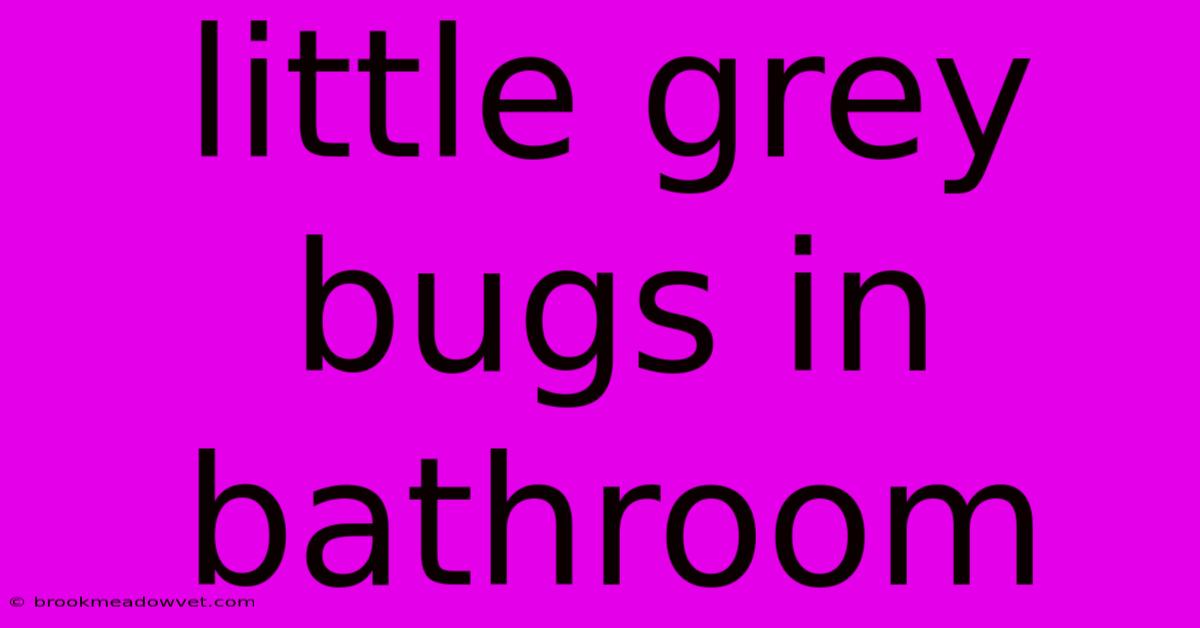Little Grey Bugs In Bathroom

Table of Contents
Little Grey Bugs in Your Bathroom: What They Are and How to Get Rid of Them
Finding tiny grey bugs in your bathroom can be unsettling. These unwelcome guests can quickly become a nuisance, crawling across surfaces and leaving you questioning their origin and how to get rid of them. This article will guide you through identifying these common bathroom invaders and provide practical tips to banish them for good.
Common Culprits: Unmasking the Grey Bugs
While the "little grey bug" description is quite broad, several culprits frequently invade bathrooms, each requiring a slightly different approach.
1. Silverfish: These nocturnal, fast-moving insects are easily recognized by their silvery-grey color, elongated body, and three long appendages at the rear. Silverfish are attracted to damp, dark areas with access to carbohydrates, like wallpaper paste, book bindings, or even damp fabric.
2. Booklice: These tiny, wingless insects are often mistaken for silverfish due to their similar size and color. Booklice, however, are more oval-shaped and lack the prominent appendages of silverfish. They feed on mold and mildew, making damp bathrooms a perfect habitat.
3. Springtails: These tiny insects, usually less than 1/8 inch long, are known for their ability to jump surprisingly high distances. They are often grey or black and favor moist environments, such as damp baseboards and underneath sinks.
Why Are They in My Bathroom?
The presence of these little grey bugs in your bathroom often points to a few key factors:
- Excess Moisture: Bathrooms are naturally humid, offering a perfect breeding ground for these moisture-loving creatures.
- Food Sources: Residual food particles, spilled beverages, and even organic materials like hair and skin can attract these insects.
- Damp Surfaces: Leaking pipes, inadequate ventilation, or even condensation can create damp areas that are ideal for these bugs.
Banishing the Bugs: A Step-by-Step Guide
Now that you know the culprits, it's time to take action:
1. Reduce Moisture:
- Ventilate: Ensure adequate ventilation by using exhaust fans during and after showers.
- Dry Surfaces: Wipe down surfaces with a dry cloth after each use, especially around the shower or bathtub.
- Fix Leaks: Immediately address any leaky pipes or faucets to prevent persistent dampness.
2. Eliminate Food Sources:
- Clean Regularly: Thoroughly clean your bathroom, paying attention to corners, crevices, and under sinks.
- Seal Food: Store food in airtight containers to prevent access for these pests.
- Dispose of Trash: Empty garbage bins regularly and keep them clean.
3. Natural Repellents:
- Diatomaceous Earth: Sprinkle this natural powder around areas where you see bugs, creating a barrier they can't cross.
- Cedarwood Oil: Add a few drops of cedarwood oil to a spray bottle filled with water and mist around the bathroom.
- Eucalyptus Oil: Similar to cedarwood oil, eucalyptus oil can deter these creatures.
4. Professional Help:
If your bathroom infestation is severe or persistent, consider calling a professional pest control service for targeted treatment.
Preventing Future Infestations
- Regular Cleaning: Regular bathroom cleaning and maintenance are essential to prevent the return of these bugs.
- Ventilation: Ensure proper ventilation to minimize humidity and reduce moisture levels.
- Moisture Control: Address any leaky pipes or faucets promptly to prevent long-term dampness.
By understanding the common culprits and adopting these simple prevention strategies, you can reclaim your bathroom from these unwelcome guests. Remember, a clean and dry bathroom is the best defense against little grey bugs and other bathroom pests.

Thank you for visiting our website wich cover about Little Grey Bugs In Bathroom. We hope the information provided has been useful to you. Feel free to contact us if you have any questions or need further assistance. See you next time and dont miss to bookmark.
Featured Posts
-
Patio Furniture And Umbrellas
Nov 14, 2024
-
Ceiling Fan In Dining Room
Nov 14, 2024
-
Dinosaur Landscape Toy
Nov 14, 2024
-
Bathroom Sheets Instead Of Tiles
Nov 14, 2024
-
Antique Furniture Rollers
Nov 14, 2024

